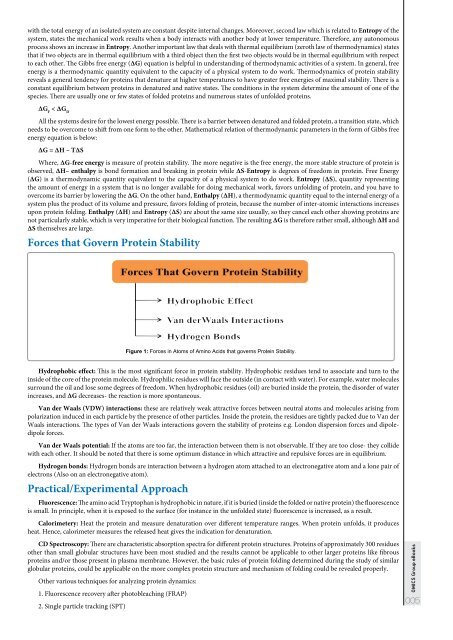Create successful ePaper yourself
Turn your PDF publications into a flip-book with our unique Google optimized e-Paper software.
with the total energy of an isolated system are constant despite <strong>in</strong>ternal changes. Moreover, second law which is related to Entropy of the<br />
system, states the mechanical work results when a body <strong>in</strong>teracts with another body at lower temperature. Therefore, any autonomous<br />
process shows an <strong>in</strong>crease <strong>in</strong> Entropy. Another important law that deals with thermal equilibrium (zeroth law of thermodynamics) states<br />
that if two objects are <strong>in</strong> thermal equilibrium with a third object then the first two objects would be <strong>in</strong> thermal equilibrium with respect<br />
to each other. The Gibbs free energy (ΔG) equation is helpful <strong>in</strong> understand<strong>in</strong>g of thermodynamic activities of a system. In general, free<br />
energy is a thermodynamic quantity equivalent to the capacity of a physical system to do work. Thermodynamics of prote<strong>in</strong> stability<br />
reveals a general tendency for prote<strong>in</strong>s that denature at higher temperatures to have greater free energies of maximal stability. There is a<br />
constant equilibrium between prote<strong>in</strong>s <strong>in</strong> denatured and native states. The conditions <strong>in</strong> the system determ<strong>in</strong>e the amount of one of the<br />
species. There are usually one or few states of folded prote<strong>in</strong>s and numerous states of unfolded prote<strong>in</strong>s.<br />
ΔG F<br />
< ΔG D<br />
All the systems desire for the lowest energy possible. There is a barrier between denatured and folded prote<strong>in</strong>, a transition state, which<br />
needs to be overcome to shift from one form to the other. Mathematical relation of thermodynamic parameters <strong>in</strong> the form of Gibbs free<br />
energy equation is below:<br />
ΔG = ΔH – TΔS<br />
Where, ΔG-free energy is measure of prote<strong>in</strong> stability. The more negative is the free energy, the more stable structure of prote<strong>in</strong> is<br />
observed, ΔH– enthalpy is bond formation and break<strong>in</strong>g <strong>in</strong> prote<strong>in</strong> while ΔS-Entropy is degrees of freedom <strong>in</strong> prote<strong>in</strong>. Free Energy<br />
(ΔG) is a thermodynamic quantity equivalent to the capacity of a physical system to do work. Entropy (ΔS), quantity represent<strong>in</strong>g<br />
the amount of energy <strong>in</strong> a system that is no longer available for do<strong>in</strong>g mechanical work, favors unfold<strong>in</strong>g of prote<strong>in</strong>, and you have to<br />
overcome its barrier by lower<strong>in</strong>g the ΔG. On the other hand, Enthalpy (ΔH), a thermodynamic quantity equal to the <strong>in</strong>ternal energy of a<br />
system plus the product of its volume and pressure, favors fold<strong>in</strong>g of prote<strong>in</strong>, because the number of <strong>in</strong>ter-atomic <strong>in</strong>teractions <strong>in</strong>creases<br />
upon prote<strong>in</strong> fold<strong>in</strong>g. Enthalpy (ΔH) and Entropy (ΔS) are about the same size usually, so they cancel each other show<strong>in</strong>g prote<strong>in</strong>s are<br />
not particularly stable, which is very imperative for their biological function. The result<strong>in</strong>g ΔG is therefore rather small, although ΔH and<br />
ΔS themselves are large.<br />
Forces that Govern Prote<strong>in</strong> Stability<br />
Figure 1: Forces <strong>in</strong> Atoms of Am<strong>in</strong>o Acids that governs Prote<strong>in</strong> Stability.<br />
Hydrophobic effect: This is the most significant force <strong>in</strong> prote<strong>in</strong> stability. Hydrophobic residues tend to associate and turn to the<br />
<strong>in</strong>side of the core of the prote<strong>in</strong> molecule. Hydrophilic residues will face the outside (<strong>in</strong> contact with water). For example, water molecules<br />
surround the oil and lose some degrees of freedom. When hydrophobic residues (oil) are buried <strong>in</strong>side the prote<strong>in</strong>, the disorder of water<br />
<strong>in</strong>creases, and ΔG decreases- the reaction is more spontaneous.<br />
Van der Waals (VDW) <strong>in</strong>teractions: these are relatively weak attractive forces between neutral atoms and molecules aris<strong>in</strong>g from<br />
polarization <strong>in</strong>duced <strong>in</strong> each particle by the presence of other particles. Inside the prote<strong>in</strong>, the residues are tightly packed due to Van der<br />
Waals <strong>in</strong>teractions. The types of Van der Waals <strong>in</strong>teractions govern the stability of prote<strong>in</strong>s e.g. London dispersion forces and dipoledipole<br />
forces.<br />
Van der Waals potential: If the atoms are too far, the <strong>in</strong>teraction between them is not observable. If they are too close- they collide<br />
with each other. It should be noted that there is some optimum distance <strong>in</strong> which attractive and repulsive forces are <strong>in</strong> equilibrium.<br />
Hydrogen bonds: Hydrogen bonds are <strong>in</strong>teraction between a hydrogen atom attached to an electronegative atom and a lone pair of<br />
electrons (Also on an electronegative atom).<br />
Practical/Experimental Approach<br />
Fluorescence: The am<strong>in</strong>o acid Tryptophan is hydrophobic <strong>in</strong> nature, if it is buried (<strong>in</strong>side the folded or native prote<strong>in</strong>) the fluorescence<br />
is small. In pr<strong>in</strong>ciple, when it is exposed to the surface (for <strong>in</strong>stance <strong>in</strong> the unfolded state) fluorescence is <strong>in</strong>creased, as a result.<br />
Calorimetery: Heat the prote<strong>in</strong> and measure denaturation over different temperature ranges. When prote<strong>in</strong> unfolds, it produces<br />
heat. Hence, calorimeter measures the released heat gives the <strong>in</strong>dication for denaturation.<br />
CD Spectroscopy: There are characteristic absorption spectra for different prote<strong>in</strong> structures. Prote<strong>in</strong>s of approximately 300 residues<br />
other than small globular structures have been most studied and the results cannot be applicable to other larger prote<strong>in</strong>s like fibrous<br />
prote<strong>in</strong>s and/or those present <strong>in</strong> plasma membrane. However, the basic rules of prote<strong>in</strong> fold<strong>in</strong>g determ<strong>in</strong>ed dur<strong>in</strong>g the study of similar<br />
globular prote<strong>in</strong>s, could be applicable on the more complex prote<strong>in</strong> structure and mechanism of fold<strong>in</strong>g could be revealed properly.<br />
Other various techniques for analyz<strong>in</strong>g prote<strong>in</strong> dynamics:<br />
1. Fluorescence recovery after photobleach<strong>in</strong>g (FRAP)<br />
2. S<strong>in</strong>gle particle track<strong>in</strong>g (SPT)<br />
OMICS Group eBooks<br />
005



